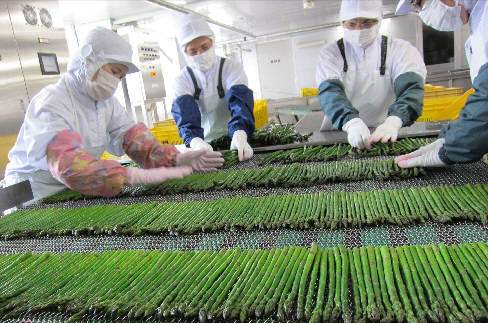Hirobumi Senbongi
Japanese producers of frozen vegetables are seeking ways to increase their market share, as rising labor costs in China – the main supplier of frozen vegetables – and the weaker yen are leading to strengthen price competitiveness of domestic products.
In order to help stabilize farmers’ incomes, officials of Japanese agricultural cooperatives which produce frozen vegetables say they are looking to increase production if their products, which they say are higher in quality than imported products, prove to be more competitive in the market.
According to the Japan Frozen Food Association, consumption of frozen food in 2012 marked a record high of 2.7 million tons in terms of volume, or 895.1 billion yen in terms of value, with imports occupying 30% of the total. Imports of frozen vegetables totaled 133.1 billion yen in the same year, out of which 60.1 billion yen worth – nearly half – was shipped from China.
Imports of frozen vegetables from China were up 3.8% from a year before, marking a year-on-year increase for four consecutive years, helped by a large gap between prices of domestic and imported products, the association said. The average price of imported frozen vegetables was 140 yen per kilogram in 2012, while that of domestically produced frozen vegetables was 286 yen, roughly twice as much.
However, it will become increasingly difficult for imports from China to maintain their rising trend, as labor costs in China have shown increases in recent years. According to a survey conducted by the Japan External Trade Organization on some 500 companies operating in China, payroll costs in the manufacturing sector increased 10 to 14% every year in the last three fiscal years. As a result, personnel expenses, including social security benefits, rose 60% during the same period.
Labor costs of farmers who produce vegetables in China’s rural areas are said to be rising as well. Since the Chinese Communist Party has set a 10-year target of doubling the nation’s per-capita income by 2020, production costs of frozen vegetables in China are highly likely to keep on increasing.
Prices of Chinese products are affected also by currency fluctuations. Until last year, the rising labor cost in China was offset by the high yen, but the frozen food association predicts that this year, prices of imported products will rise at least 20% from last year due to weakening of the yen.
Price gaps between domestic and imported products will shrink, the association official said, adding that there is a high possibility for domestic products to increase their market share.
As restaurants and fast food shops prefer cheap imported products, yearly production of frozen vegetables in Japan has maintained the level of no more than 30 billion yen in the last five years. But domestic suppliers are making efforts to increase sales by cutting costs and offering products which meet the consumers’ needs.
JA Higashikagura, an agricultural cooperative in northern Hokkaido, has been producing frozen vegetables since 1985, as fresh vegetables grown in Hokkaido, such as asparaguses, are harvested and shipped around the same period throughout the region, and excessive supply tend to lead to drop in prices of fresh vegetables.
To help stabilize farmers’ incomes, the agricultural cooperative has set up its own processing plant to freeze vegetables. While the average price of fresh vegetables is 600 yen per kilogram, frozen vegetables sell at the average price of more than 1,000 yen.
The cooperative’s yearly sales of frozen vegetables amount to 65 million yen for asparaguses, 55 million yen for sweet corns and 30 million yen for pumpkins, adding up to roughly 10% of their total sales of vegetables. The products are used mainly by hospitals and schools which place importance on providing safe food.
The cooperative’s frozen vegetable business is in the black, even including labor costs for part-time workers of the plant, thanks to cost cutting measures such as the use of high-yielding varieties of pumpkins and sweet corns which are fit for freezing.
Ryo Minami, a cooperative official, said their frozen asparaguses are better in taste and color than imported products, adding that they can appeal the products’ quality more if their price competitiveness increases. The cooperative will consider increasing production of frozen vegetables if there are more chances of making profits, Minami said.
Tadamichi Isoda, an official of Izux, a Tokyo-based dealer of domestic and imported agricultural products including frozen vegetables, said frozen products using domestically-grown vegetables will have more sales potential if producers take further cost cutting measures and select items unique to each region. Responding to different customer needs such as by offering vegetable pastes, as well as fresh-cut vegetables, is also necessary, Isoda added.
(Aug. 19, 2013)


